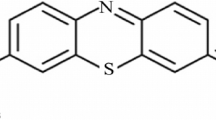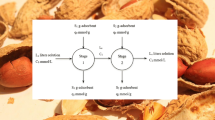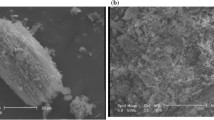Abstract
This study utilizes spent carrot seed waste (SCSW) as an adsorbent for the removal of methylene blue dye from synthetic wastewater. The influence of reaction parameters—temperature, pH, time, dye concentration, adsorbent dose, and RPM—is studied to maximize the adsorption capacity and dye removal. The hybrid optimization design approach (DoE + manual) reveals that dye concentration and adsorbent dose are the primary influencing factors. SCSW exhibits a maximum adsorption capacity of 234 mg/g, achieving approximately 98% dye removal. Langmuir, Freundlich, and Temkin isotherms are employed, with the best fit observed at 50 °C. Kinetic analysis reveals that the adsorption process adheres to the pseudo-first and pseudo-second-order processes, as well as the Elovich model at all dye concentrations. The equilibrium models suggest that the adsorption of Methylene Blue dye molecules is monolayer and multilayer onto the heterogeneous surface of SCSW. The kinetic and thermodynamic studies imply that the adsorption process is exothermic and physico-chemical in nature. Finally, regeneration of dye-coated SCSW is performed to check its reusability and found that thermochemical regeneration is the appropriate method for regeneration.
Graphical Abstract






Similar content being viewed by others
Data Availability
The datasets generated during and/or analyzed during the current study are available from the corresponding author on reasonable request.
References
Abu Bakar, M. S., Ahmed, A., Jeffery, D. M., Hidayat, S., Sukri, R. S., Mahlia, T. M. I., et al. (2020). Pyrolysis of solid waste residues from Lemon Myrtle essential oils extraction for bio-oil production. Bioresource Technology, 318(June), 1–5. https://doi.org/10.1016/j.biortech.2020.123913
Al-Ghouti, M. A., & Al-Absi, R. S. (2020). Mechanistic understanding of the adsorption and thermodynamic aspects of cationic methylene blue dye onto cellulosic olive stones biomass from wastewater. Scientific Reports, 10(1). https://doi.org/10.1038/s41598-020-72996-3
Al-Ghouti, M. A., & Da’ana, D. A. (2020). Guidelines for the use and interpretation of adsorption isotherm models: A review. Journal of Hazardous Materials, 393(January), 122383. https://doi.org/10.1016/j.jhazmat.2020.122383
Al-Gorair, A. S., Sayed, A., & Mahmoud, G. A. (2022). Engineered superabsorbent nanocomposite reinforced with cellulose nanocrystals for remediation of basic dyes: Isotherm, kinetic, and thermodynamic studies. Polymers, 14(3). https://doi.org/10.3390/polym14030567
Ali, I., Khan, D., Mehmood, T., & Khan, A. (2021). Removal of Uranium U(IV) from aqueous solution using acid treated spent tea leaves. Current Research in Green and Sustainable Chemistry, 4(October), 100197. https://doi.org/10.1016/j.crgsc.2021.100197
Aljeboree, A. M., Alshirifi, A. N., & Alkaim, A. F. (2017). Kinetics and equilibrium study for the adsorption of textile dyes on coconut shell activated carbon. Arabian Journal of Chemistry, 10, S3381–S3393. https://doi.org/10.1016/j.arabjc.2014.01.020
Basha, I. K., Abd El-Monaem, E. M., Khalifa, R. E., Omer, A. M., & Eltaweil, A. S. (2022). Sulfonated graphene oxide impregnated cellulose acetate floated beads for adsorption of methylene blue dye: Optimization using response surface methodology. Scientific Reports, 12(1). https://doi.org/10.1038/s41598-022-13105-4
Gopal, N., Asaithambi, M., Sivakumar, P., & Sivakumar, V. (2014). Adsorption studies of a direct dye using polyaniline coated activated carbon prepared from Prosopis juliflora. Journal of Water Process Engineering, 2, 87–95. https://doi.org/10.1016/j.jwpe.2014.05.008
Guo, D., Li, Y., Cui, B., Hu, M., Luo, S., Ji, B., & Liu, Y. (2020). Natural adsorption of methylene blue by waste fallen leaves of Magnoliaceae and its repeated thermal regeneration for reuse. Journal of Cleaner Production, 267, 121903. https://doi.org/10.1016/j.jclepro.2020.121903
Gupta, V. K., Gupta, B., Rastogi, A., Agarwal, S., & Nayak, A. (2011). A comparative investigation on adsorption performances of mesoporous activated carbon prepared from waste rubber tire and activated carbon for a hazardous azo dye-Acid Blue 113. Journal of Hazardous Materials, 186(1), 891–901. https://doi.org/10.1016/j.jhazmat.2010.11.091
Ichipi, E. O., Mapossa, A. B., Costa, A. C. F. M., Chirwa, E. M. N., & Tichapondwa, S. M. (2023). Fabrication and characterization of recyclable, magnetic (CoFe2O4)x/Ag2S-ZnO composites for visible-light-induced photocatalytic degradation of methylene blue dye. Journal of Water Process Engineering, 54(June). https://doi.org/10.1016/j.jwpe.2023.104040
Iheanacho, O. C., Nwabanne, J. T., Obi, C. C., Igwegbe, C. A., Onu, C. E., & Dahlan, I. (2023). Adsorptive dephenolization of aqueous solutions using thermally modified corn cob: mechanisms, point of zero charge, and isosteric heat studies. Adsorption Science and Technology, 2023. https://doi.org/10.1155/2023/2813663
Iqbal, J., Shah, N. S., Sayed, M., Imran, M., Muhammad, N., Howari, F. M., et al. (2019). Synergistic effects of activated carbon and nano-zerovalent copper on the performance of hydroxyapatite-alginate beads for the removal of As 3 þ from aqueous solution. Journal of Cleaner Production, 235, 875–886. https://doi.org/10.1016/j.jclepro.2019.06.316
Jain, H., Yadav, V., Rajput, V. D., Minkina, T., Agarwal, S., & Garg, M. C. (2022). An eco-sustainable green approach for biosorption of methylene blue dye from textile industry wastewater by sugarcane bagasse, peanut hull, and orange peel: A comparative study through response surface methodology, isotherms, kinetic, and thermodynamics. Water, Air, & Soil Pollution, 233(6), 187. https://doi.org/10.1007/s11270-022-05655-0
Khan, A., Wang, X., Gul, K., Khuda, F., Aly, Z., & Elseman, A. M. (2018). Microwave-assisted spent black tea leaves as cost-effective and powerful green adsorbent for the efficient removal of Eriochrome black T from aqueous solutions. Egyptian Journal of Basic and Applied Sciences, 5(2), 171–182. https://doi.org/10.1016/j.ejbas.2018.04.002
Kheddo, A., Rhyman, L., Elzagheid, M. I., Jeetah, P., & Ramasami, P. (2020). Adsorption of synthetic dyed wastewater using activated carbon from rice husk. SN Applied Sciences, 2(12), 1–14. https://doi.org/10.1007/s42452-020-03922-5
Kumar, D., Patel, Z., Pandit, P., Pandit, R., Patel, A., Joshi, M., & Joshi, C. (2021). Textile industry wastewaters from Jetpur, Gujarat, India, are dominated by Shewanellaceae, Bacteroidaceae, and Pseudomonadaceae harboring genes encoding catalytic enzymes for textile dye degradation. Frontiers in Environmental Science, 9(September), 1–15. https://doi.org/10.3389/fenvs.2021.720707
Mansour, R. A. E. G., Simeda, M. G., & Zaatout, A. A. (2021). Removal of brilliant green dye from synthetic wastewater under batch mode using chemically activated date pit carbon. RSC Advances, 11(14), 7851–7861. https://doi.org/10.1039/d0ra08488c
Maruthapandi, M., Kumar, V. B., Luong, J. H. T., & Gedanken, A. (2018). Kinetics, isotherm, and thermodynamic studies of methylene blue adsorption on polyaniline and polypyrrole macro-nanoparticles synthesized by C-dot-initiated polymerization. ACS Omega, 3(7), 7196–7203. https://doi.org/10.1021/acsomega.8b00478
Milonjić, S. K., Ruvarac, A. L., & Šušić, M. V. (1975). The heat of immersion of natural magnetite in aqueous solutions. Thermochimica Acta, 11(3), 261–266. https://doi.org/10.1016/0040-6031(75)85095-7
Modak, S., Katiyar, P., Yadav, S., & Hans, A. (2023). Valorization of lignocellulosic solid waste obtained from essential oil industry for bio-oil production and dye removal. Water Practice and Technology, 18(10), 2384–2400. https://doi.org/10.2166/wpt.2023.154
Momina, M. S., & Suzylawati, I. (2020). Study of the adsorption/desorption of MB dye solution using bentonite adsorbent coating. Journal of Water Process Engineering, 34(July 2019). https://doi.org/10.1016/j.jwpe.2020.101155
Montgomery, D. C. (2017). Design and analysis of experiments. John wiley & sons.
Oladoye, P. O., Ajiboye, T. O., Omotola, E. O., & Oyewola, O. J. (2022). Methylene blue dye: Toxicity and potential elimination technology from wastewater. Results in Engineering, 16(August), 100678. https://doi.org/10.1016/j.rineng.2022.100678
Patidar, K., & Vashishtha, M. (2020). Optimization of process variables to prepare mesoporous activated carbon from mustard straw for dye adsorption using response surface methodology. Water, Air, & Soil Pollution, 231(10), 526. https://doi.org/10.1007/s11270-020-04893-4
Sahoo, T. R., & Prelot, B. (2020). Adsorption processes for the removal of contaminants from wastewater: The perspective role of nanomaterials and nanotechnology. In Nanomaterials for the Detection and Removal of Wastewater Pollutants (pp. 161–222). Elsevier Inc.. https://doi.org/10.1016/B978-0-12-818489-9.00007-4
Sahu, S., Pahi, S., Tripathy, S., Singh, S. K., Behera, A., Sahu, U. K., & Patel, R. K. (2020). Adsorption of methylene blue on chemically modified lychee seed biochar: Dynamic, equilibrium, and thermodynamic study. Journal of Molecular Liquids, 315, 113743. https://doi.org/10.1016/j.molliq.2020.113743
Sharif, K. M., Rahman, M. M., Azmir, J., Mohamed, A., Jahurul, M. H. A., Sahena, F., & Zaidul, I. S. M. (2014). Experimental design of supercritical fluid extraction - A review. Journal of Food Engineering. https://doi.org/10.1016/j.jfoodeng.2013.10.003
Subramani, S. E., & Thinakaran, N. (2017). Isotherm, kinetic and thermodynamic studies on the adsorption behaviour of textile dyes onto chitosan. Process Safety and Environmental Protection, 106, 1–10. https://doi.org/10.1016/j.psep.2016.11.024
Truzzi, E., Chaouch, M. A., Rossi, G., Tagliazucchi, L., Bertelli, D., & Benvenuti, S. (2022). Characterization and valorization of the agricultural waste obtained from Lavandula steam distillation for its reuse in the food and pharmaceutical fields. Molecules, 27(5). https://doi.org/10.3390/molecules27051613
Unugul, T., & Nigiz, F. U. (2020). Preparation and Characterization an Active Carbon Adsorbent from Waste Mandarin Peel and Determination of Adsorption Behavior on Removal of Synthetic Dye Solutions. Water, Air, and Soil Pollution, 231(11). https://doi.org/10.1007/s11270-020-04903-5
Xu, R., Mao, J., Peng, N., Luo, X., & Chang, C. (2018). Chitin/clay microspheres with hierarchical architecture for highly efficient removal of organic dyes. Carbohydrate Polymers, 188, 143–150. https://doi.org/10.1016/j.carbpol.2018.01.073
Zhu, Y., Yi, B., Yuan, Q., Wu, Y., Wang, M., & Yan, S. (2018). Removal of methylene blue from aqueous solution by cattle manure-derived low temperature biochar. RSC Advances, 8(36), 19917–19929. https://doi.org/10.1039/c8ra03018a
Author information
Authors and Affiliations
Corresponding author
Ethics declarations
Conflict of Interest
The authors declare no competing interests.
Additional information
Publisher’s Note
Springer Nature remains neutral with regard to jurisdictional claims in published maps and institutional affiliations.
Supplementary Information
ESM 1
(DOCX 13912 kb)
Rights and permissions
Springer Nature or its licensor (e.g. a society or other partner) holds exclusive rights to this article under a publishing agreement with the author(s) or other rightsholder(s); author self-archiving of the accepted manuscript version of this article is solely governed by the terms of such publishing agreement and applicable law.
About this article
Cite this article
Modak, S., Katiyar, P., Kumar, G. et al. Effective Removal of Methylene Blue Dye Using Low-Cost Essential Oil Industry Waste: Novel Hybrid Design Approach, Kinetic and Thermodynamic Evaluation. Water Air Soil Pollut 235, 213 (2024). https://doi.org/10.1007/s11270-024-07009-4
Received:
Accepted:
Published:
DOI: https://doi.org/10.1007/s11270-024-07009-4




